Pre-Reading
Pre-Reading Activity
Look at the definition below. Then, discuss the questions below.
biome: ecological community of plants, animals, and other organisms that is adapted to a characteristic set of environmental condition
- The definition uses many complex words. In simple terms, what is a biome?
- This reading is about terrestrial (land) biomes. There are eight major types of terrestrial biomes. Do you know what they are?
- Quickly preview the text, to check your answers to question 2. How many terrestrial biomes did you correctly identify?
- What type of biome do you live in? What type of vegetation does it have? How much precipitation does it get?
Reading 3: Terrestrial Biomes [1]
The Earth’s biomes are categorized into two major groups: terrestrial and aquatic. Terrestrial biomes are based on land, while aquatic biomes include both ocean and freshwater biomes. The eight major terrestrial biomes on Earth are each distinguished by characteristic temperatures and amount of precipitation. Comparing the annual totals of precipitation and fluctuations in precipitation from one biome to another provides clues as to the importance of abiotic factors in the distribution of biomes. Temperature variation on a daily and seasonal basis is also important for predicting the geographic distribution of the biome and the vegetation type in the biome. The distribution of these biomes shows that the same biome can occur in geographically distinct areas with similar climates (Figure 6).

Tropical Wet Forest
Tropical wet forests are also referred to as tropical rainforests. This biome is found in equatorial regions near the earth’s equator (Figure 6). The vegetation is characterized by plants with broad leaves that fall off throughout the year. Unlike the trees of deciduous forests, the trees in this biome do not have a seasonal loss of leaves associated with variations in temperature and sunlight; these forests are “evergreen” year-round.
The temperature and sunlight profiles of tropical wet forests are very stable in comparison to that of other terrestrial biomes, with the temperatures ranging from 20 °C to 34 °C (68 °F to 93 °F). When one compares the annual temperature variation of tropical wet forests with that of other forest biomes, the lack of seasonal temperature variation in the tropical wet forest becomes apparent. This lack of seasonality leads to year-round plant growth, rather than the seasonal (spring, summer, and fall) growth seen in other biomes. In contrast to other ecosystems, tropical ecosystems do not have long days and short days during the yearly cycle. Instead, a constant daily amount of sunlight (11–12 hours per day) provides more solar radiation, thereby, a longer period of time for plant growth.
The annual rainfall in tropical wet forests ranges from 125 to 660 cm (50–200 in) with some monthly variation. While sunlight and temperature remain fairly consistent, annual rainfall often changes. Tropical wet forests have wet months in which there can be more than 30 cm (11–12 in) of rain, as well as dry months in which there are fewer than 10 cm (3.5 in) of rain. However, the driest month of a tropical wet forest still exceeds the annual rainfall of some other biomes, such as deserts.
Tropical wet forests have high net primary productivity because the annual temperatures and precipitation values in these areas are ideal for plant growth. Therefore, the extensive biomass present in the tropical wet forest leads to plant communities with very high species diversities (Figure 7). Tropical wet forests have more species of trees than any other biome; on average between 100 and 300 species of trees are present in a single hectare (2.5 acres) of South America. One way to visualize this is to compare the distinctive horizontal layers within the tropical wet forest biome. On the forest floor is a sparse layer of plants and decaying plant matter. Above that is an understory of short shrubby foliage. A layer of trees rises above this understory and is topped by a closed upper canopy—the uppermost overhead layer of branches and leaves. Some additional trees emerge through this closed upper canopy. These layers provide diverse and complex habitats for the variety of plants, fungi, animals, and other organisms within the tropical wet forests. For instance, epiphytes are plants that grow on other plants, which typically are not harmed. Epiphytes are found throughout tropical wet forest biomes. Many species of animals use the variety of plants and the complex structure of the tropical wet forests for food and shelter. Some organisms live several meters above ground and have adapted to this arboreal lifestyle.

Savannas
Savannas are grasslands with scattered trees, and they are located in Africa, South America, and northern Australia (Figure 6). Savannas are hot, tropical areas with temperatures averaging from 24 °C to 29 °C (75 °F to 84 °F) and an annual rainfall of 10–40 cm (3.9–15.7 in). Savannas have an extensive dry season; for this reason, forest trees do not grow as well as they do in the tropical wet forest (or other forest biomes). As a result, within the grasses and forbs (herbaceous flowering plants) that dominate the savanna, there are relatively few trees (Figure 8). Since fire is an important source of disturbance in this biome, plants have evolved well-developed root systems that allow them to quickly re-sprout after a fire.

Subtropical Deserts
Subtropical deserts exist between 15 ° and 30 ° north and south latitude and are centered on the Tropics of Cancer and Capricorn (Figure 6). This biome is very dry; in some years, evaporation exceeds precipitation. Subtropical hot deserts can have daytime soil surface temperatures above 60 °C (140 °F) and nighttime temperatures approaching 0 °C (32 °F). In cold deserts, temperatures can be as high as 25 °C and can drop below -30 °C (-22 °F). Subtropical deserts are characterized by low annual precipitation of fewer than 30 cm (12 in) with little monthly variation and lack of predictability in rainfall. In some cases, the annual rainfall can be as low as 2 cm (0.8 in) in subtropical deserts located in central Australia (“the Outback”) and northern Africa.
The vegetation and low animal diversity of this biome is closely related to this low and unpredictable precipitation. Very dry deserts lack perennial vegetation that lives from one year to the next; instead, many plants are annuals that grow quickly and reproduce when rainfall does occur, then they die. Many other plants in these areas are characterized by having a number of adaptations that conserve water, such as deep roots, reduced foliage, and water-storing stems (Figure 9). Seed plants in the desert produce seeds that can be in dormancy for extended periods between rains. Adaptations in desert animals include nighttime, nocturnal behavior and burrowing underground.
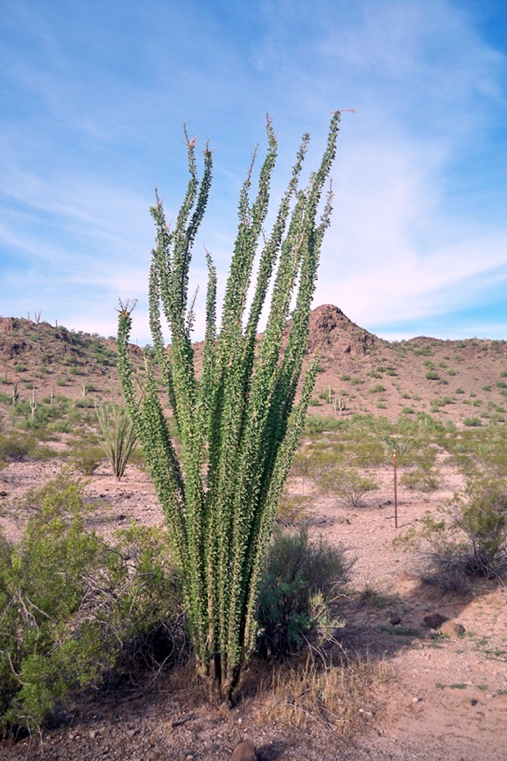
Chaparral
The chaparral is also called the scrub forest and is found in California, along the Mediterranean Sea, and along the southern coast of Australia (Figure 6). The annual rainfall in this biome ranges from 65 cm to 75 cm (25.6–29.5 in), and the majority of the rain falls in the winter. Summers are very dry and many chaparral plants are dormant during the summertime. The chaparral vegetation, shown in Figure 10, is dominated by shrubs and is adapted to periodic fires, with some plants producing seeds that only grow after a hot fire. The ashes left behind after a fire are rich in nutrients like nitrogen that fertilize the soil and promote plant regrowth.
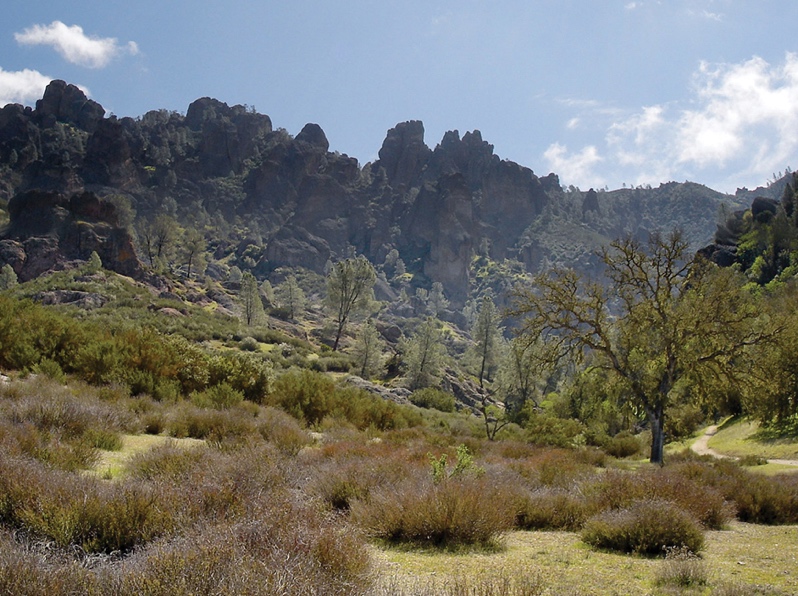
Temperate Grasslands
Temperate grasslands are found throughout central North America, where they are also known as prairies; they are also in Eurasia, where they are known as steppes (Figure 6). Temperate grasslands have pronounced annual fluctuations in temperature with hot summers and cold winters. The annual temperature variation produces specific growing seasons for plants. Plant growth is possible when temperatures are warm enough to sustain plant growth and when ample water is available, which occurs in the spring, summer, and fall. During much of the winter, temperatures are low, and water, which is stored in the form of ice, is not available for plant growth.
Annual precipitation ranges from 25 cm to 75 cm (9.8–29.5 in). Because of relatively lower annual precipitation in temperate grasslands, there are few trees except for those found growing along rivers or streams. The dominant vegetation tends to consist of grasses and some prairies sustain populations of grazing animals, which eat grass (Figure 11). The vegetation is very dense and the soils are fertile because the subsurface of the soil is packed with the roots and rhizomes (underground stems) of these grasses. The roots and rhizomes act to anchor plants into the ground and replenish the organic material (humus) in the soil when they die and decay.
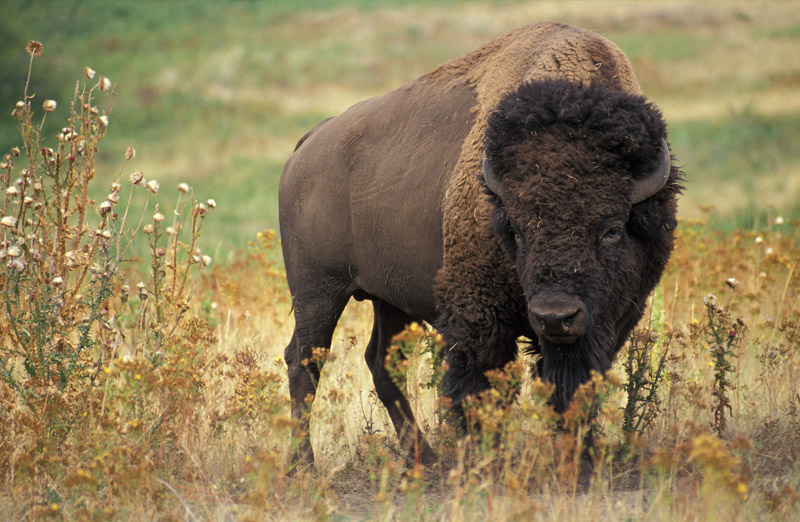
Fires, mainly caused by lightning, are a natural disturbance in temperate grasslands. When fire is suppressed in temperate grasslands, the vegetation eventually converts to scrub and dense forests. Often, the restoration or management of temperate grasslands requires the use of controlled burns to suppress the growth of trees and maintain the grasses.
Temperate Forests
Temperate forests are the most common biome in eastern North America, Western Europe, Eastern Asia, Chile, and New Zealand (Figure 6). This biome is found throughout mid-latitude regions. Temperatures range between -30 °C and 30 °C (-22 °F to 86 °F) and drop to below freezing on an annual basis. These temperatures mean that temperate forests have defined growing seasons during the spring, summer, and early fall. Precipitation is relatively constant throughout the year and ranges between 75 cm and 150 cm (29.5–59 in).
Because of the moderate annual rainfall and temperatures, deciduous trees are the dominant plant in this biome (Figure 12). Deciduous trees lose their leaves each fall and remain leafless in the winter. Thus, no photosynthesis occurs in the deciduous trees during the dormant winter period. Each spring, new leaves appear as the temperature increases. Because of the dormant period, the net primary productivity of temperate forests is less than that of tropical wet forests. In addition, temperate forests show less diversity of tree species than tropical wet forest biomes.
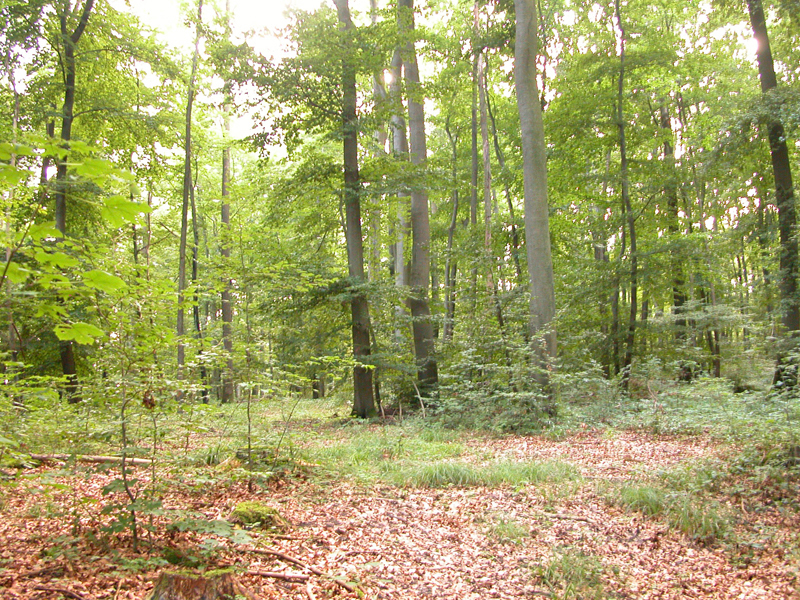
The trees of the temperate forests grow somewhat dense leaf cover and shade much of the ground; however, this biome is more open than tropical wet forests because trees in the temperate forests do not grow as tall as the trees in tropical wet forests. The soils of the temperate forests are rich in inorganic and organic nutrients. This is due to the thick layer of leaf litter on forest floors. As this leaf litter decays, nutrients are returned to the soil. The leaf litter also protects soil from erosion, insulates the ground, and provides habitats for invertebrates (such as the pill bug or roly-poly, Armadillidium vulgare) and their predators, such as the red-backed salamander (Plethodon cinereus).
Boreal Forests
The boreal forest, also known as taiga or coniferous forest, is found south of the Arctic Circle and across most of Canada, Alaska, Russia, and northern Europe (Figure 6). This biome has cold, dry winters and short, cool, wet summers. The annual precipitation is from 40 cm to 100 cm (15.7–39 in) and usually takes the form of snow. Little evaporation occurs because of the cold temperatures.
The long and cold winters in the boreal forest have led to the predominance of cold-tolerant cone-bearing plants. These are evergreen coniferous trees like pines, spruce, and fir, which retain their needle-shaped leaves year-round. Evergreen trees can photosynthesize earlier in the spring than deciduous trees because less energy from the sun is required to warm a needle-like leaf than a broad leaf. This benefits evergreen trees, which grow faster than deciduous trees in the boreal forest. In addition, soils in boreal forest regions tend to be acidic with little available nitrogen. Leaves are a nitrogen-rich structure and deciduous trees must produce a new set of these nitrogen-rich structures each year. Therefore, coniferous trees that retain nitrogen-rich needles may have a competitive advantage over the broad-leafed deciduous trees.
The net primary productivity of boreal forests is lower than that of temperate forests and tropical wet forests. The aboveground biomass of boreal forests is high because these slow-growing tree species are long lived and accumulate standing biomass over time. Plant species diversity is less than that seen in temperate forests and tropical wet forests. Boreal forests lack the pronounced elements of the layered forest structure seen in tropical wet forests. The structure of a boreal forest is often only a tree layer and a ground layer (Figure 13). When conifer needles are dropped, they decompose more slowly than broad leaves; therefore, fewer nutrients are returned to the soil to fuel plant growth.

Arctic Tundra
The Arctic tundra lies north of the subarctic boreal forest and is located throughout the Arctic regions of the northern hemisphere (Figure 6). The average winter temperature is -34 °C (-34 °F) and the average summer temperature is from 3 °C to 12 °C (37 °F–52 °F). Plants in the arctic tundra have a very short growing season of approximately 10–12 weeks. However, during this time, there are almost 24 hours of daylight and plant growth is rapid. The annual precipitation of the Arctic tundra is very low with little annual variation in precipitation. And, as in the boreal forests, there is little evaporation due to the cold temperatures.
Plants in the Arctic tundra are generally low to the ground (Figure 14). There is little species diversity, low net primary productivity, and low aboveground biomass. The soils of the Arctic tundra may remain in a perennially frozen state referred to as permafrost. The permafrost makes it impossible for roots to penetrate deep into the soil and slows the decay of organic matter, which inhibits the release of nutrients from organic matter. During the growing season, the ground of the Arctic tundra can be completely covered with plants or lichens.
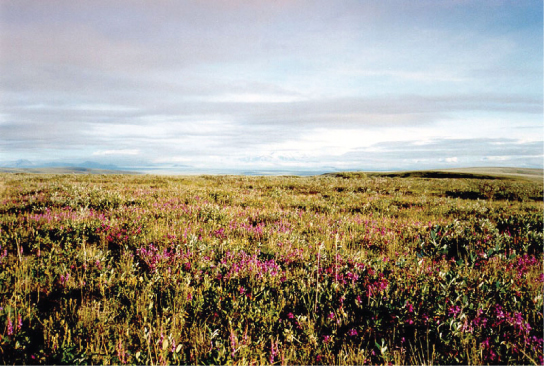
Reading Comprehension
Choose the best answer to the following questions.
- Which is usually the hottest terrestrial biome of the following?
- savannas
- tropical wet forests
- temperate forests
- subtropical deserts
- Which of the following statements about biomes is false?
- Chaparral is dominated by shrubs.
- Savannas and temperate grasslands are dominated by grasses.
- Boreal forests are dominated by deciduous trees.
- Lichens are common in the arctic tundra.
- Which of the following biomes is characterized by abundant water resources?
- deserts
- boreal forests
- savannas
- tropical wet forests
- Which of the following biomes is characterized by short growing seasons?
- deserts
- tropical wet forests
- arctic tundras
- savannas
Read the statements. Put T for True or F for False. If the statement is false, correct the error to make the statement true.
- ______ Aquatic biomes include both freshwater and marine environments.
- ______ There are only seven major terrestrial biomes: tropical wet forests, savannas, subtropical deserts, chaparral, temperate grasslands, boreal forests, and Arctic tundra.
- ______ Variations in temperature and precipitation shape the composition of animal and plant communities in terrestrial biomes.
- ______ Some biomes, such as tropical wet forests, have distinct seasons, with cold weather and hot weather alternating throughout the year.
Complete the table below by comparing two terrestrial biomes of your choice.
|
|
Biome 1: ___________________ |
Biome 2: __________________ |
|
9. Location |
|
|
|
10. Climate (temperature and perception) |
|
|
|
11. Vegetation |
|
|
|
12. Other Information |
|
|
Vocabulary Practice
Read the paragraphs, and notice the bold academic words. Then, match the bold words with their definitions below.
While the weather forecast only predicted scattered showers over the weekend, the city has seen record-breaking amounts of rain. The waters have flooded hundreds of homes, predominately in the area adjacent to the river. In that area, several feet of water have accumulated in homes. Other areas have only been moderately affected. Still the local schools have been converted into a shelter to help those in need.
The situation now seems stable and will not get any worse for at least 12 hours. After that, predictions are unclear. The fluctuating temperatures and wind conditions may complicate the situation. Gas and electrical power have been cut off temporarily, thereby preventing fires. The mayor has also deployed police to the streets to suppress riots or theft. He promised order would be restored quickly and said that the flood would not inhibit economic growth and development in the area.
- ______________________________ (adv) in that way
- ______________________________ (adj) changing; increasing and decreasing
- ______________________________ (v) to slowdown or prevent something
- ______________________________ (adj) occurring in a random or unorganized way
- ______________________________ (adv) minorly; not greatly
- ______________________________ (adv) mainly
- ______________________________ (adj) unchanging
- ______________________________ (v) to change something to serve a new purpose
- ______________________________ (v) to stop something from happening or being felt
- ______________________________ (v) to be collected in an increasing number or amount over time
Reading Discussion
Discuss these questions with your classmates.
- The extremely low precipitation of subtropical desert biomes might lead one to expect fire to be a major disturbance factor; however, fire is more common in the temperate grassland biome than in the subtropic desert biome. Why is this?
- In what ways are the subtropical desert and the arctic tundra similar?
- What is primary productivity? Explain why deserts and tundra have low primary productivity.
- In tropical wet forests, why is the net primary productivity high?
- Download the original, un-adapted version for free at https://cnx.org/contents/jVCgr5SL@15.47:xiJu444u@12/44-3-Terrestrial-Biomes ↵
